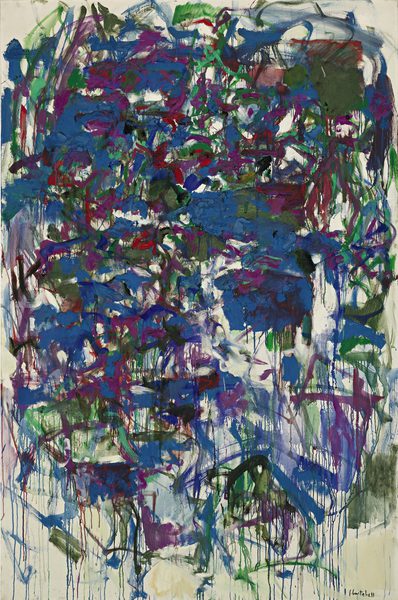Joan Mitchell
Joan Mitchell was a significant American abstract expressionist painter whose works are an inextricable part of post-war art history. Her unique style and artistic contributions, particularly in the realms of abstract expressionism and color field painting, are invaluable parts of both movements.
Born on February 12, 1925, in Chicago, Illinois, Joan Mitchell showed an early interest in art and creativity. She studied at Smith College in Massachusetts and later attended the School of the Art Institute of Chicago, where she developed her artistic vision. Mitchell's formative years were greatly influenced by the vibrant art scene in Chicago, which played a pivotal role in shaping her style and approach.
In the early 1950s, Joan Mitchell moved to New York City, where she became an integral part of the abstract expressionist movement that was sweeping through the art world. Abstract expressionism, characterised by its emphasis on spontaneous, gestural brushwork and the expression of emotional intensity, provided Mitchell with a platform to explore her own artistic voice. She quickly established herself as a prominent figure within this artistic milieu, alongside fellow artists Jackson Pollock, Willem de Kooning, and Mark Rothko. Mitchell's works from this period are characterized by bold, energetic brushstrokes, vibrant colors, and a sense of movement and dynamism.
Her paintings often evoke a sense of raw emotion and intensity, reflecting her own inner turmoil and struggles. Despite the abstract nature of her works, Mitchell's paintings are deeply personal and reflective of her own experiences and emotions. Throughout her career, Joan Mitchell continued to push the boundaries of abstract expressionism, experimenting with new techniques and styles while staying true to her artistic vision. Her works evolved over time, reflecting her own growth and development as an artist. Mitchell drew inspiration from a variety of sources, including nature, music, and poetry, which infused her works with a sense of vitality and depth.
In the 1960s, Joan Mitchell moved to France, where she lived and worked for much of her later life. The French countryside provided Mitchell with a new source of inspiration, as she immersed herself in the natural beauty and landscapes of the region. Her works from this period are marked by a more subdued color palette and a sense of serenity and contemplation, reflecting the influence of her surroundings. Despite her success and critical acclaim, Joan Mitchell remained somewhat on the fringes of the mainstream art world. While her male counterparts were often celebrated and recognised for their contributions to abstract expressionism, Mitchell's work was sometimes overlooked or marginalised. However, over time, Mitchell's legacy has been reevaluated and her importance within the art world has been acknowledged and celebrated.
Joan Mitchell's impact on the art world extends far beyond her own works. As a female artist working in a male-dominated field, Mitchell paved the way for future generations of women artists to pursue their creative visions and make their mark on the art world.
Featured Artists
- Ancart Harold
- Andre Carl
- Avery Milton
- Baldessari John
- Barnes Ernie
- Brice Lisa
- Castellani Enrico
- Crawford Brett
- Dadamaino
- Dávila Jose
- de Tollenaere Saskia
- Downing Thomas
- Dyson Julian
- Elsner Slawomir
- Freud Lucian
- Gadsby Eric
- Gander Ryan
- Guston Philip
- Haring Keith
- Held Al
- Hockney David
- Katz Alex
- Kentridge William
- Knifer Julije
- Le Parc Julio
- Leciejewski Edgar
- Levine Chris
- LeWitt Sol
- Marchéllo
- Mavignier Almir da Silva
- Miller Harland
- Modé João
- Morellet François
- Nadelman Elie
- Nesbitt Lowell Blair
- O'Donoghue Hughie
- Odita Odili Donald
- Perry Grayson
- Picasso Pablo
- Pickstone Sarah
- Prehistoric Objects
- Quinn Marc
- Riley Bridget
- Ruscha Ed
- Serra Richard
- Shrigley David
- Smith Anj
- Smith Richard
- Soto Jesús Rafael
- Soulages Pierre
- Spencer Stanley
- Taller Popular de Serigrafía
- The Connor Brothers
- Turk Gavin
- Vasarely Victor
- Wood Jonas

